Coin Values Moving with Precious Metals: Up-Dated 4/14/2025: Gold $3226 | Silver $31.88
1956 Penny Value
Locating 1956 penny value on the chart involves two initial steps. First: Identify the mint that struck the coin, confirming date and mint mark variety.
Secondly: Condition becomes a key factor in deciding on an accurate value. Small differences needed to judging grade are highlighted to compare your coin. Images in the grading section with descriptions guide the process.
A step by step method is followed to determine how much these old wheat pennies are worth.
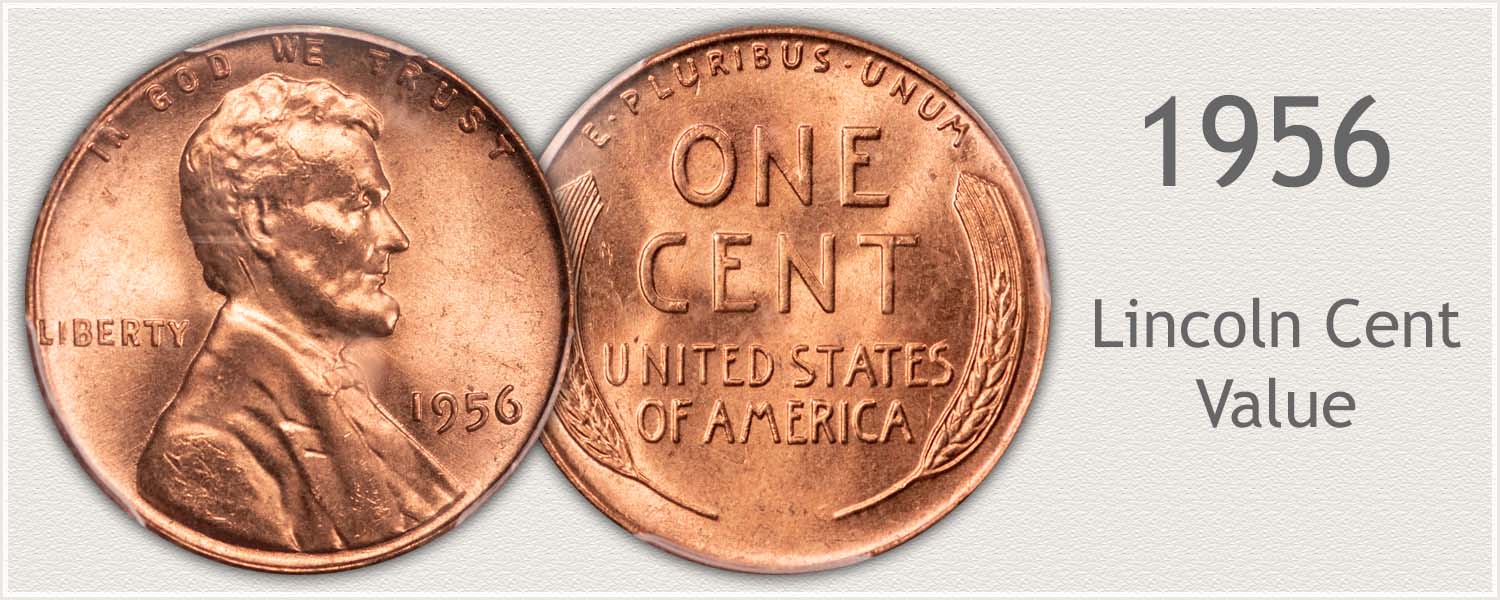
Steps Leading to Value:
- Step 1: Date and Mintmark Variety – Identify each date and its mintmark variety.
- Step 2: Grading Condition – Judge condition to determine grade.
- Step 3: Special Qualities – Certain elements either enhance or detract from value.
| 1956 Lincoln Penny Value | ||||
|---|---|---|---|---|
| Condition of Coin | ||||
| Date | Good | Fine | Extremely Fine | Uncirculated |
| 1956 Lincoln Penny Value Up-Dated | 2025 | |||
| 1956 | $0.02 | $0.02 | $0.03 | $0.65 |
| 1956 D | $0.02 | $0.02 | $0.03 | $0.68 |
Step one is to confirm exact Date and Mint Mark variety. Images used to locate mint marks finds its exact place on the chart.
Second step, is a good appraisal of condition. Matching your coin to grading images gives a good indication of its condition, helping visualize grade. It is important to judge your coin against both the images and descriptions. Metal alloy of 1956 cents has a few considerations effecting its market acceptance.
Identity of Date and Mint Mark.
Step 1: | Date and Mintmark Combination
1956 Date and Mintmark Varieties
Two varieties of 1956 pennies were produced. Combined coinage total for both varieties is the second highest of the wheat series. 1,518,946,100 produced. Standout features are boldness of design and state of preservation.
1956 Lincoln Penny
No Mintmark Under Date: Philadelphia Mint Struck the Coin
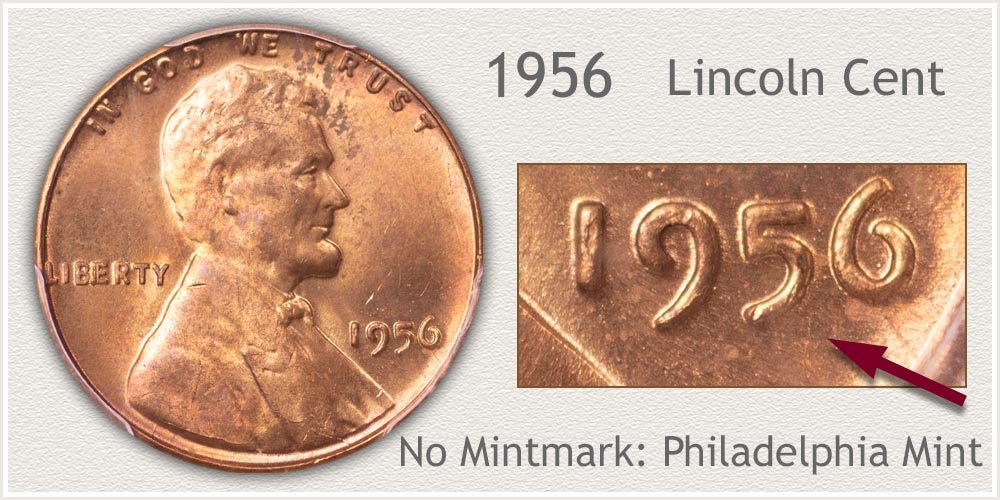
Philadelphia mint struck ample quantities of the 1956 penny. These coins are Abundant on the rarity scale. 420,745,000 coined placing 8th in the top ten most produced in a year.
With many 1956 cents available to collectors, a standout coin is one in Mint State condition. Never circulated, a "like new" penny is bright with the reddish color of newly minted copper. Circulated coins are in favor if just slightly worn, these are in the minority of those surviving. Even color, slight traces of wear, identifies a coin suitable to place in an affordable circulated set.
1956-D Lincoln Penny
"D" Mintmark Under Date: Denver Mint Struck the Coin
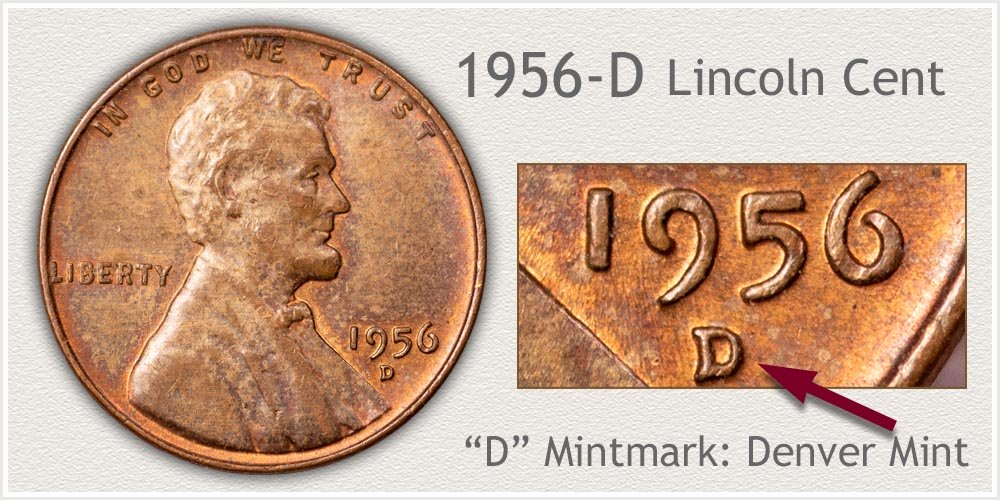
The Denver mint set a record in 1956, striking 1,098,210,100 cents, highest of the wheat cent series. A significant production achievement providing ample quantities of minor coinage. A 1956-D penny is Abundant on the rarity scale.
Appeal to collectors forms the base value of a 1956-D penny. Circulated examples are available in quantities providing many for young and beginning collectors to examine and choose for their collections. An appealing coin displays bold features of Lincoln and strong lettering and wheat ears on the reverse.
Step 2: | Judge Condition to Identify Grade
Grading Condition Confirms Value of 1956 Lincoln Penny
Grade is a definition used by collectors when describing the condition of a coin. Grades listed on the chart range from Good (heavily worn penny) to Uncirculated (no wear). Specific areas are inspected to judge condition.
Eye appeal is important to a copper coin and value as a collectible. Light coloration is preferred over dark that tends to hide finer detail.
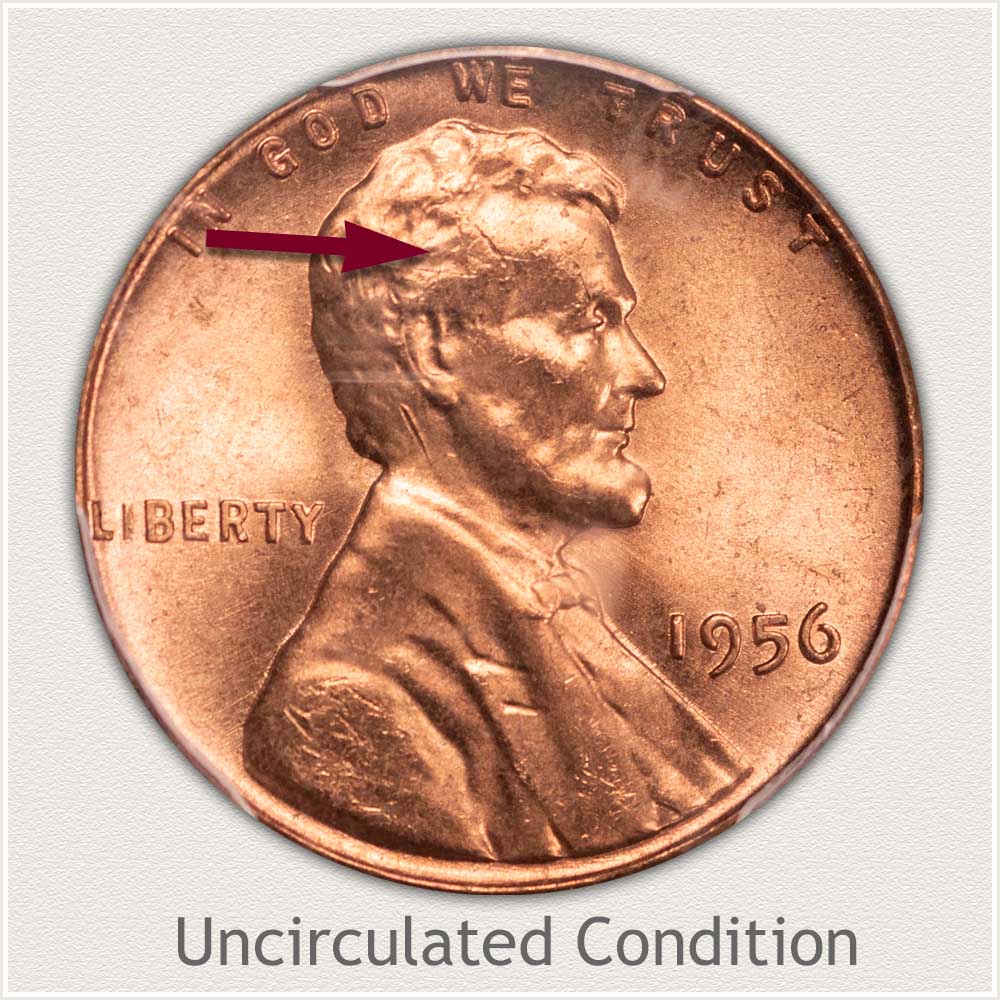
Uncirculated Grade: Mint state - uncirculated wheat cents are the elite grade with collectors. A coin preserved in the condition they left the mint. No wear has removed any detail and all elements remain sharp.
One area helpful in detecting wear is Lincoln's temple area. His temple and just in front of the ear is high in relief with low areas between. Inspect high points for any smoothing and dulling of the metal. Wear removes original texture of luster leaving a distinct change from the lower areas of the temple.
The example 1956 penny is bright with original luster. Texture of the copper remains consistent over the entire surface. Tilt at an angle to light helping see any changes in texture to confirm the mint state grade.
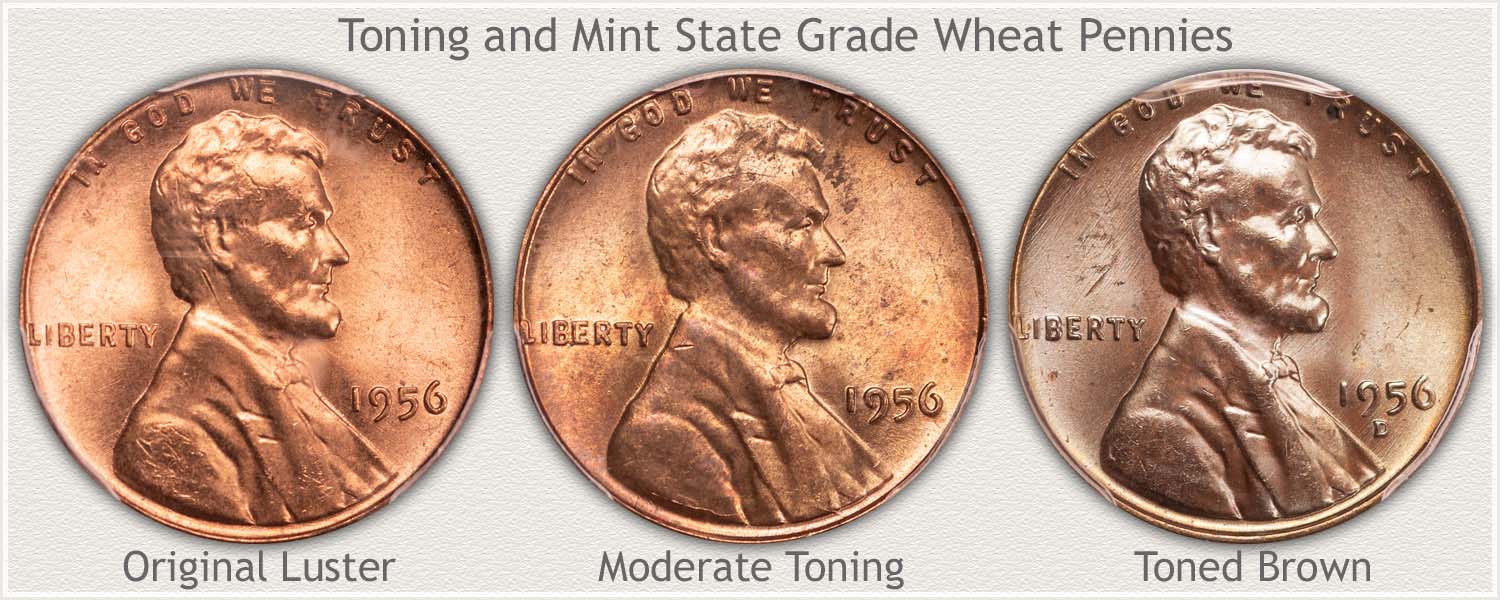
Evaluate Toning of 1956 Penny: An important part to value is color - toning of old pennies. The cent on the left remains bright with luster, a premium condition. Exposure to air is causing the penny in the middle to develop a moderate amount of toning. Eye appeal begins to determine value as a coin tones, pleasing colors are often sought by collectors. Deep toning is displayed as brown covering the surface on the far-right penny.
As you grade wheat pennies, toning is not used as an indication of wear. The 1956 penny toned brown is still an uncirculated piece because no wear is present. Toning has covered the entire surface; however, the texture of luster remains underneath.
Collector preference starts with coins displaying bright luster. Preferences and values favor moderate toning next. Brown toning follows closely after.
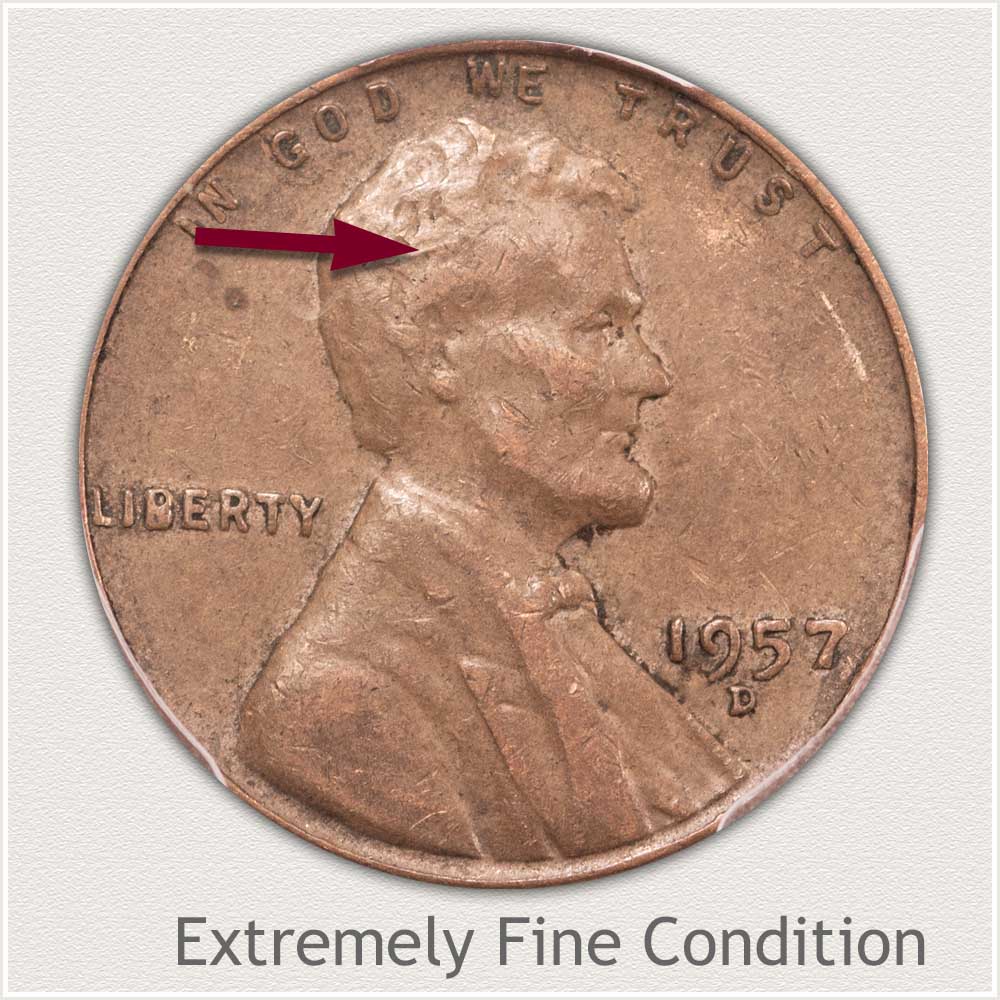
Extremely Fine Condition: A small amount of wear removing high points of the design identifies the Extremely Fine grade.
Lincoln's temple now displays a minor but distinct smoothing on the top rounded profile. His forehead above and cheek below is beginning to show a smooth texture with small areas of flattening.
Areas of the hair are also beginning to show evidence of minor flattening. Importantly, all of these design elements are separated and retain rounded profiles. Very minor is the amount of wear.
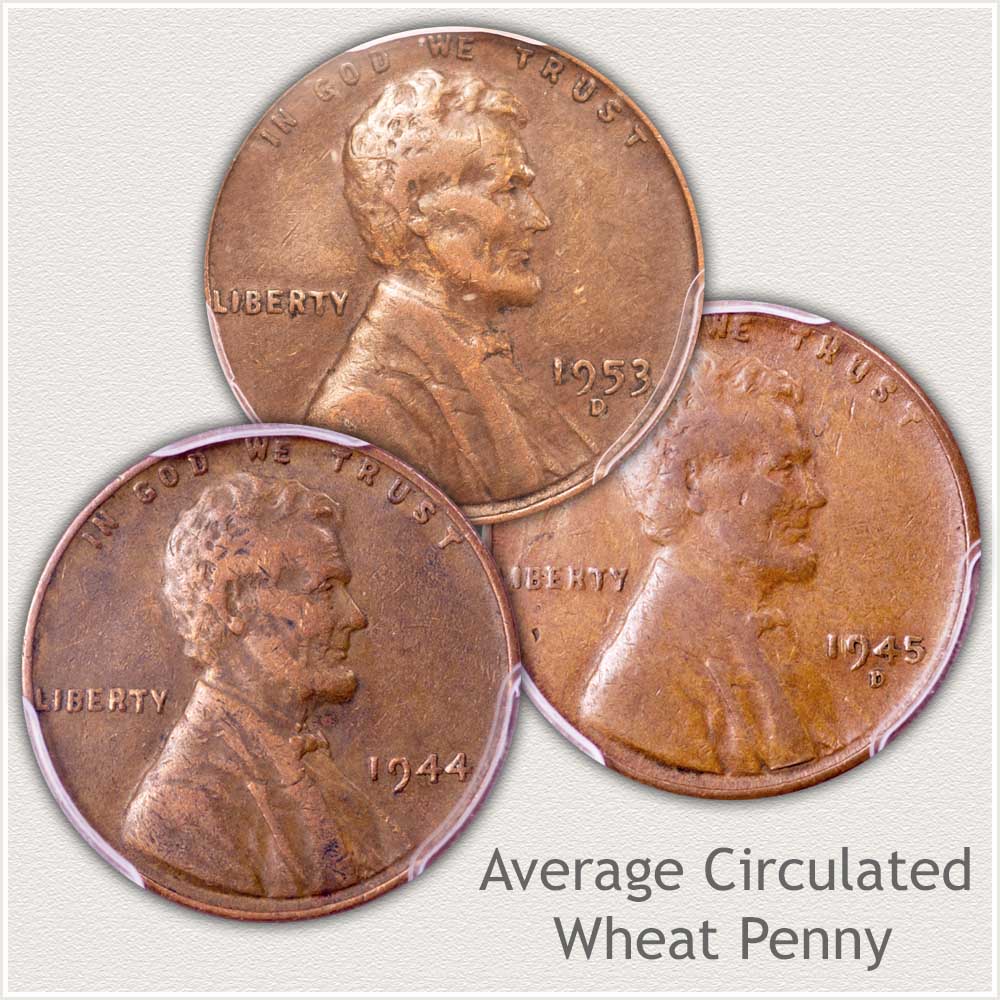
Average Circulated Condition: Large quantities of wheat pennies moderately to heavily worn are available today. Those minted in the 1950's are the bulk of these available coins. As a group they are considered average circulated.
An average circulated coin displays wear flattening many once bold features of Lincoln. His forehead, temple area, and cheek are noticeably flattened. Once bold minor features are merged and no longer separated.
Moderate to heavy wear coins are the base value examples. At this stage of condition, eye appeal becomes very important. Any noticeable distractions; dark colors, heavy marks, and excessive wear eliminates the coin from collector acceptance.
Video | Grading Lincoln Wheat Pennies
Grading any coin involves many points to judge. When either; value is high or condition is at the higher end a closer inspection of the coin is needed. Grading Lincoln Wheat Pennies expands on the grading process with video, images of the grades and in-depth descriptions.
Step 3: | Special Qualities Enhancing Value
1956 Clipped Planchet Penny Value
An error occurred during punching the strip of metal in the first stages of the minting production. Metal passes through a set of punches stamping the initial blank coin. If a misalignment occurs these "planchets" are punched in an area too close to a previous punched hole. A resulting void of varying size is missing on the planchet. Once struck an elliptical void is part of the final coin and its design.
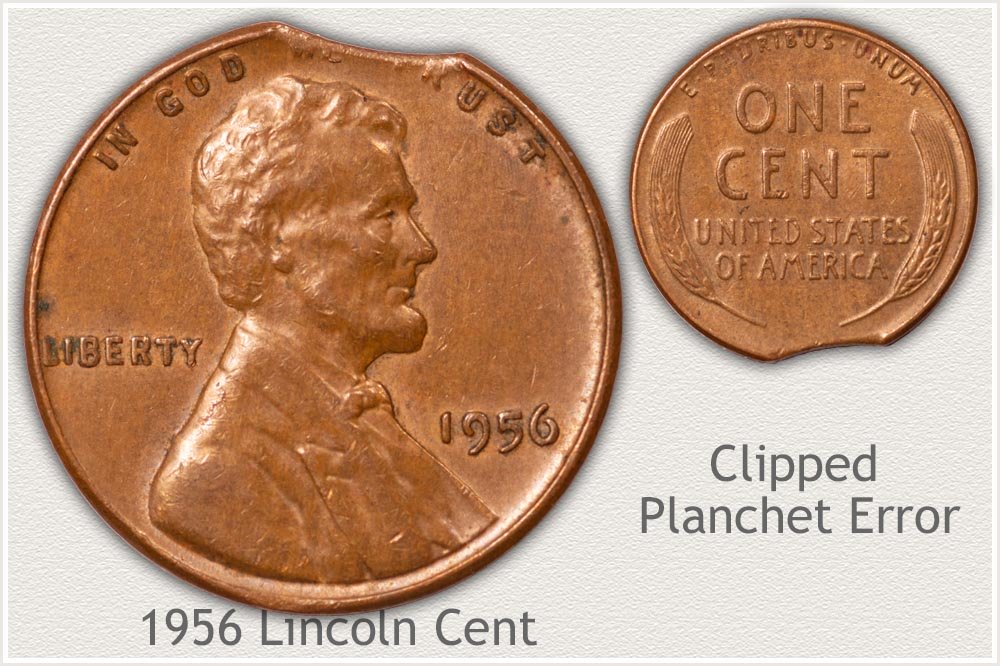
Determining value involves judging aesthetics of the remaining coin, overall condition and a sense of popularity among collectors. The example 1956 penny retains the date, a positive. Location of the clip is somewhat close to Lincoln's head, a slight drawback. Judging condition finds light wear. Mint state example clipped planchets are known, circulated examples place lower in value. Light brown toning is pleasing with no large distracting marks to the surface.
Interest shown by collectors is the deciding factor to value. Traditional collecting assembles date and mint mark sets of wheat pennies. Error collecting is a specialty pursued by fewer collectors. 1956 is an available coin in circulated condition. An interesting, pleasing clipped planchet example is worth a few dollars. Overall, worth recognizing.
ReferencesUS Mint. 1957 US Mint Annual Report https://nnp.wustl.edu/library/publisherdetail/51
Coin Values | CoinStudy Articles
Value chart spans the Wheat design years 1909 through 1958 of Lincoln cents. From uncirculated coins collected by advances collectors to worn examples an affordable collection popular with young collectors. Identify date, mint and condition; a wide range of values is found and identified.
Coin series enjoy different levels of popularity within the hobby. Lincoln cents are avidly collected and pursued. Values are directly related to their interest by collectors. Knowing a coin is in demand by many is an understanding into your coins.
Printable sheet to list and inventory your coins.
★ Coin Values Discovery finds 1956 Penny Value and...
US coin value charts covering cents to gold. Identify your coins using the image links. Date | Mintmarks | Condition are described and imaged with each series. Small details necessary to accurately value are described.